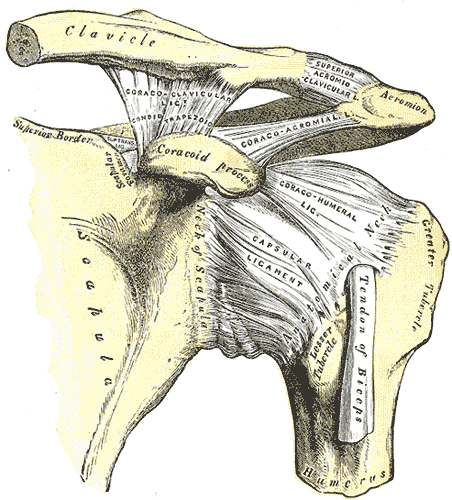Difference between revisions of "SHOULDER JOINT-LIGAMENTS"
(Imported from text file) |
(Imported from text file) |
||
| (3 intermediate revisions by the same user not shown) | |||
| Line 1: | Line 1: | ||
[[Summary Article| | ===== [[Summary Article|'''SUMMARY''']] ===== | ||
<i>1. Capsular ligaments: </i>superior gleno-humeral (lies supeior), middle gleno-humeral (lies anterior), inferior gleno-humeral (capacious, has anterior & posterior bands) | |||
<br/> | <br/> | ||
<br/><i>2. Transverse humeral ligament: </i>extends across the bicipital groove to stabilise the long head of the biceps tendon | |||
<br/> | |||
<br/><i>3. Coracohumeral ligament: </i>stabilises the intra-articular portion of the biceps tendon | |||
<br/> | |||
<br/><i>4. Coracoacromial ligament: </i>involved in the supraspinatus arch | |||
<br/> | |||
<br/><i>5. Coracoclavicular ligaments: </i>conoid & trapezoid ligaments | |||
<br/> | <br/> | ||
<br/>[[Image:Gray326.png]] | <br/>[[Image:Gray326.png]] | ||
<br/><b>Image:</b> | <br/> | ||
<br/><b>Image:</b> Henry Vandyke Carter [Public domain], [https://commons.wikimedia.org/wiki/File:Gray326.png via Wikimedia Commons] [Accessed 23 Apr. 2019]. | |||
==Reference(s)== | ==Reference(s)== | ||
Latest revision as of 18:52, 8 January 2023
SUMMARY
1. Capsular ligaments: superior gleno-humeral (lies supeior), middle gleno-humeral (lies anterior), inferior gleno-humeral (capacious, has anterior & posterior bands)
2. Transverse humeral ligament: extends across the bicipital groove to stabilise the long head of the biceps tendon
3. Coracohumeral ligament: stabilises the intra-articular portion of the biceps tendon
4. Coracoacromial ligament: involved in the supraspinatus arch
5. Coracoclavicular ligaments: conoid & trapezoid ligaments

Image: Henry Vandyke Carter [Public domain], via Wikimedia Commons [Accessed 23 Apr. 2019].
Reference(s)
R.M.H McMinn (1998). Last’s anatomy: regional and applied. Edinburgh: Churchill Livingstone.
Gray, H., Carter, H.V. and Davidson, G. (2017). Gray’s anatomy. London: Arcturus.